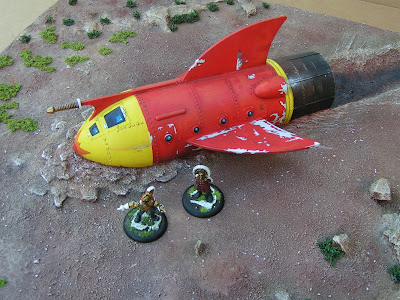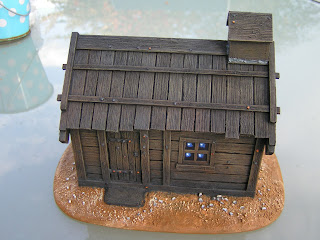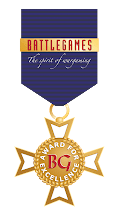Today is the 11th anniversary of this Blog and as a very special treat I am reproducing an article that was written by me for Ragnarok - the in-house publication of The Society of Fantasy and Science Fiction Wargaming or SFSFW.
Issue 60 of Ragnarok was never distributed (although there are rumours that it was indeed printed) you can buy a PDF copy from Wargames Vault, for details see this link.
Confessions of a Serial Flasher
by Tony Harwood
(Birdwatchers are
called Twitchers – Flashers are a much rarer breed - gamers who collect Flash
Gordon miniatures).
As I browsed ebay, looking for some large resin Dwarves to
convert into statues, I came across a mint, in-blister pack of (CH001) Flash
and Ming from Graven Images a pair of 40mm sculpts by Jim Bowen that I believe
to be some of the very best miniatures ever cast-up.
A bid was placed and very soon I was the proud owner of yet
another set of 40mm Flash Gordon and Emperor Ming figures.
A similar pair of character miniatures were the first Graven
Images or 40mm Cliff Hanger figures I ever bought from Monolith Designs and the
start of my 40mm Flash Gordon adventure, which today boasts over 100, 40mm
scale Flash Gordon themed figures based on Alex Raymond’s comic hero.
The original two figures quickly grew to include Professor
Zarkov, Dale and some Mongo minions. With promises of more characters to come I
waited patiently for Graven Images to produce more Flash inspired miniatures.
And waited, and waited…..
It soon became obvious that the promised new releases would
be either delayed or as it happened never sculpted. Not being one to be hampered
by the lack of similar sized or themed figures, I started looking around for
suitable proxy figures to increase and supplement my collection. One of the
first was Thun (the Lionman) who was a simple conversion of a 40mm Werewolf
miniatures from the same manufacturer, Green-stuff and Milliput were used in the
modifications and basing the miniature on the same 40mm bevelled-edged or
premium round base of the earlier figures I had produced my first Flash
conversion. Price Barin, Princess Aura and even Klytus followed.
(By basing ALL of the miniatures on to the same style round
bases, then building the groundwork and painting them in a similar style, I
believe that I have been able to maintain a level of uniformity across the
widely differing models and manufacturers).
Some time later another set of Mongo minions and both pairs
of officers were added – all three sets modified or converted in some way to
follow one of my many reference sources. The inspiration I use are numerous,
firstly the Alex Raymond original comic strip, secondly the Buster Crab black
and white cliff hanger series, thirdly the iconic Flash film with the fantastic
Queen soundtrack and then (and this may surprise some) the Flash Gordon cartoon
series. Other less well know or less well advertised reference sources for
Flash Gordon include the Internet, foreign language annuals and even the film
Flesh Gordon!
I knew that to increase my collection I had to be more
inventive in sourcing suitable figures and started to search through current
and out-of production miniature manufacturer catalogues, even resorting to
bargain bit purchases from traditional toy stores and UK Pound stores. To help
‘size’ suitable minis, I converted a small plastic ruler cutting it down to
credit card size so I would always have a 40mm scaling chart in my wallet (and yes
I still have it!)
As well as the individual figures or miniatures, I have
scratch-built a Flash Gordon Rocketship, a Sci-Fi tank (from a second-hand GW
Rhino) and four large terrain boards, The Tomb, The Rock Kings Throne Room, The
Amber Shrine and finally, my personal favourite – The Crashed Rocketship (see above).
So far I have the obvious character miniatures, Flash, Ming,
Zarkov, Dale, then Prince Barin, Aura and even Prince Voltan. The Mongo minions
and a whole host of creatures – Mudmen, Lionmen, Molemen, Beastmen, Hawkmen,
etc. The collection also includes Harpy Bats, Mud Monsters, Lizard or
Insectmen, Robotmen and Robots, Dinosaurs, Ice Giants and Dragons, the list is
almost endless.
In addition to the original Graven Images figures, the collection
includes miniatures from; Games Workshop, Mithril Miniatures, Privateer Press,
D&D plastics, Superheroes, a Tescos Dinosaurs, Foundry, Hoards of the
Things, Disney franchise toys, Monster-in-my-Pocket, Reaper Miniatures,
Heroclix, Spartan Games, Grim Reaper, Lance & Laser, Alternative Armies,
Dick Garrison, Bronze Age Miniatures, Grenadier Miniatures, Ral Partha,
Flashing Blades, Dark Age, Hydra and even Star Wars. Most are converted or at
least modified. The huge variation in manufacturer linked by one thing – their
scale, 40mm tall or can be used alongside my 40mm tall Flash Gordon miniatures.
As well as the figures, the books, the annuals and the
magazines, I have a number of ‘Golden-Age Sci-Fi or Pulp Wargame rules, however,
I have still to find the perfect Flash Gordon Skirmish Rules. A challenge for
the future!
You can read more about this even increasing collection by
checking-up on my Blog and searching the Label Flash Gordon. For details go to this link.
The Photos…..
Thun (the Lionman) a converted Werewolf from Graven Images. Dale, a stock figure from the Graven Images Cliff Hanger range. Flash, a slightly modified Flash Gordon miniature from the Graven Images Cliff Hanger range and Doctor Zarkov again from the Cliff Hanger range.
The classical Ming the Merciless figure from the Graven Images Cliff Hanger range. Prince Vultan, a major conversion/scratch-built figure. Princess Aura, a converted Dale miniature from Graven Images and Prince Barin, another major conversion based on the Graven Image figure of Zarkov.
Mongo Minions – converted soldiers from Graven Images.
Green, Crystal Entity from Reaper Miniatures. Frost Giant from Ral Partha. Sharkman from Reaper and Monkeyman from the Monster-in-my-Pocket toy figure set.
Gorillion from D&D, Beastman from Reaper Miniatures, Umber Hulk from Grim Reaper and Rockman a Stone Golem from Reaper Miniatures.
The Robots – Dick Grayson Robot, modified Hydra Legionnaires Robot, Tomb Guard from Privateer Press and modified Salute limited edition Robot.
Happy Anniversary.
Tony









































